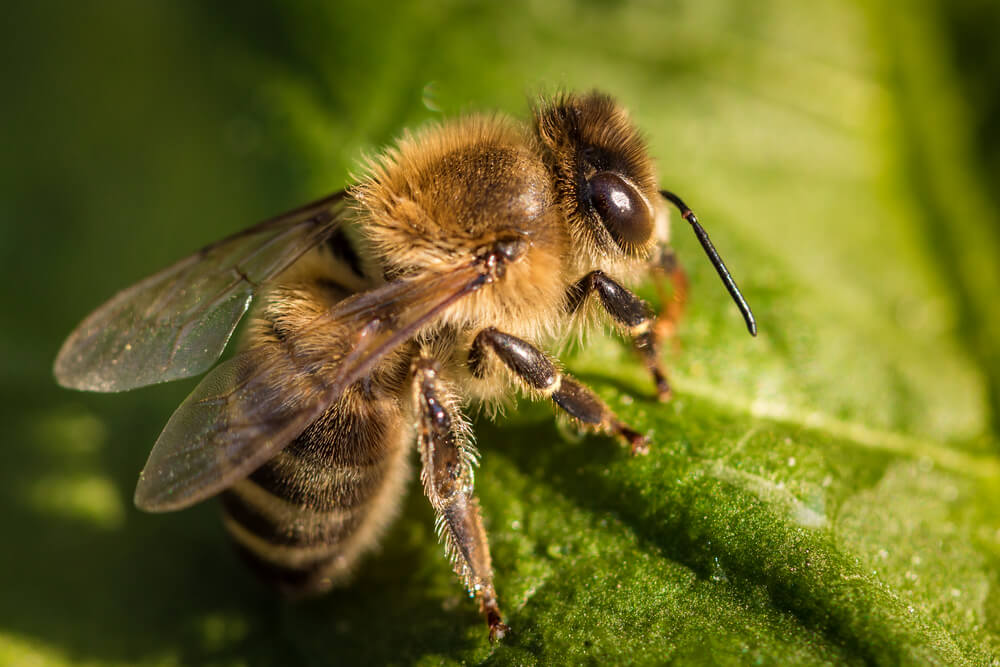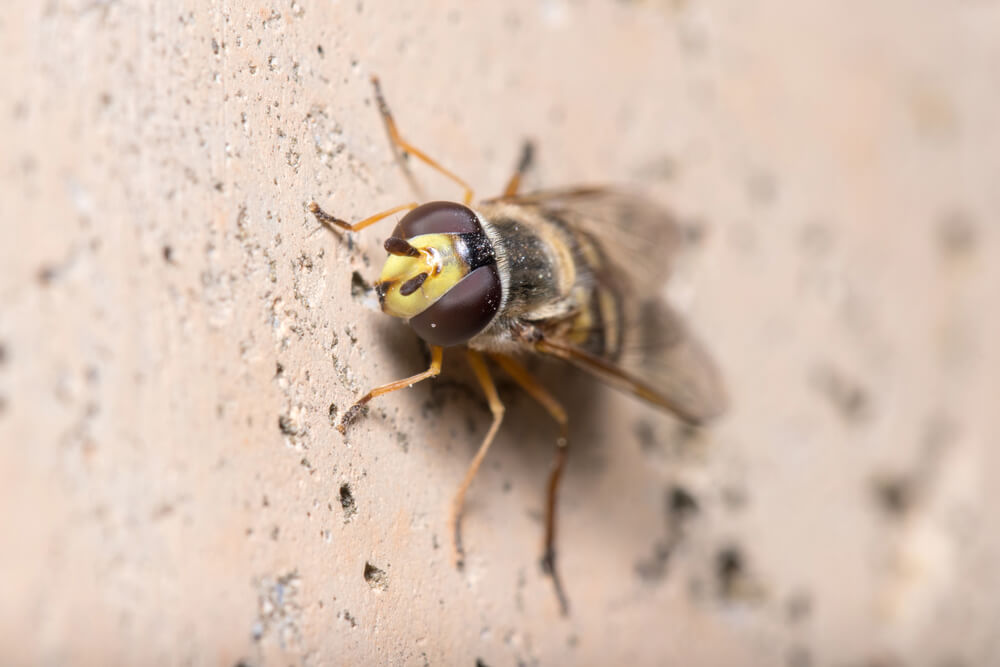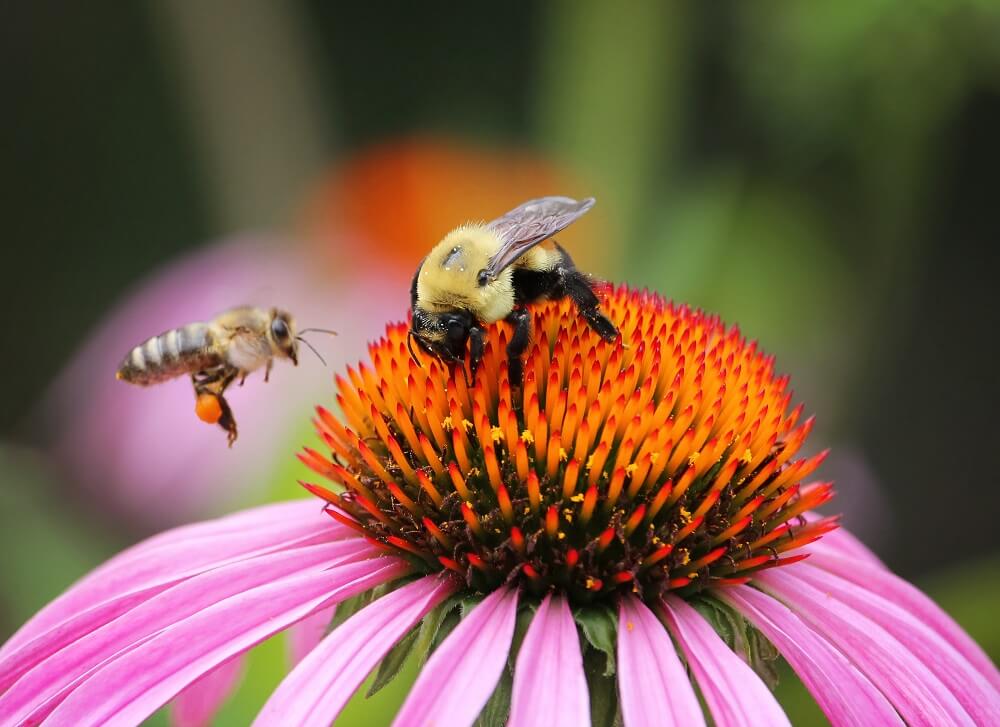Table of Contents:
What Do Bees’ Wings Look Like?
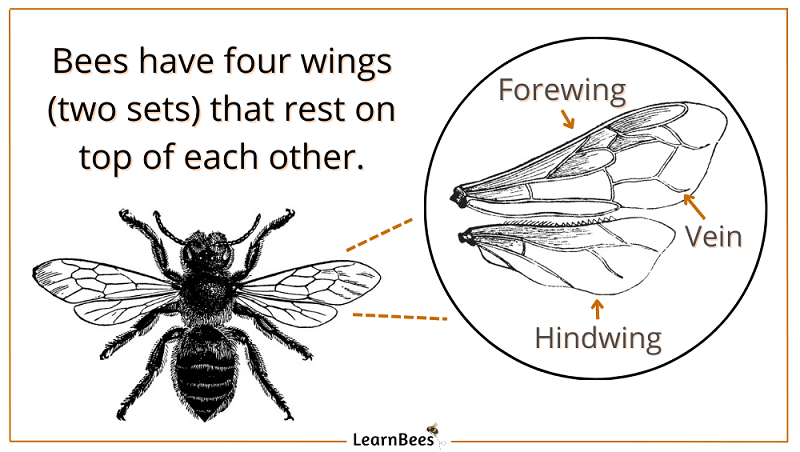
Bees have four wings, with two forewings (front) and two hindwings (back).
Most bees’ wings look very thin and transparent. If you look closely, you’ll see several veins filled with hemolymph (insect blood) running through the wings.
Interestingly enough?
Some bees have colorful wings.
For example, the violet carpenter bee (Xylocopa violacea) has a gorgeous violet/blue sheen to its wings.
Violet carpenter bees are native to Europe and Asia. Thanks to their passive nature and large size, carpenter bees are known as “gentle giants.”
With that said:
Violet carpenter bees are unique with their colored wings. Most bee species don’t have colored wings. Instead, they have transparent wings that have a clear, glass-like appearance.
And here’s the thing:
Even though bee wings may look small and delicate, they’re actually transportation powerhouses.
Take bumble bees, for example.
Bumble bees use their wings to help them carry up to 80% of their body weight.
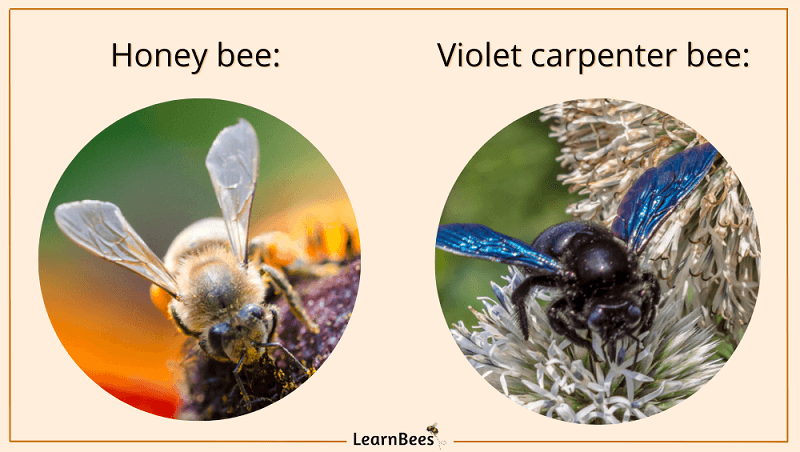
That’s like a 180-pound person carrying a backpack weighing 144 pounds. In other words, bumble bees are the heavyweight champs of the insect world.(1)
But that’s not all.
Honey bees can beat their wings up to 240 times per second.(2)
This means that honey bees can beat their wings three times faster than hummingbirds can. In fact, their wings move so quickly that you can’t even see them. Scientists have to watch slow-motion videos of honey bees to count the number of wing beats.
More importantly?
Bees are fast creatures.
Honey bees can reach top speeds of 20 mph. They’re also known for traveling more than two miles in search of flowers for food. As a result, a honey bee could fly two miles in about six minutes.
What Is Special About Bees’ Wings?
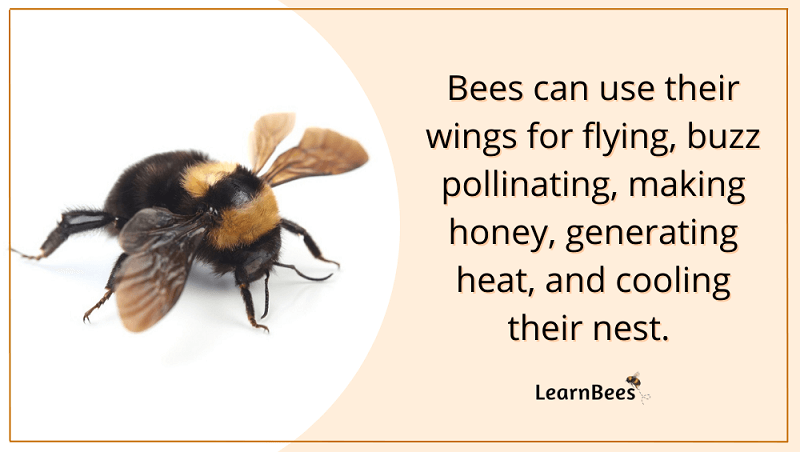
Bees’ wings are special because they use them for more than just flying.
For starters, bees use their wings to cool down their nest when it gets too hot. A group of bees will gather at the nest entrance and quickly fan cool air inside. Meanwhile, other bees will temporarily leave the nest to allow for more room and airflow.
To take it a step further?
When temperatures get too warm, the bees will also collect water from nearby sources to cool things off.
From there, the bees will use their wings to fan the water around the nest. This allows the temperature to cool as the water evaporates.
Why is this important?
Because if the nest gets too hot, then the bee larvae can dehydrate and die. Additionally, the queen quits laying eggs and production stops.
This works both ways, though.
When bees get too cold, they’ll vibrate their wings quickly to warm themselves up. Social bee colonies, like bumble bees and honey bees, will also cluster together to generate heat.
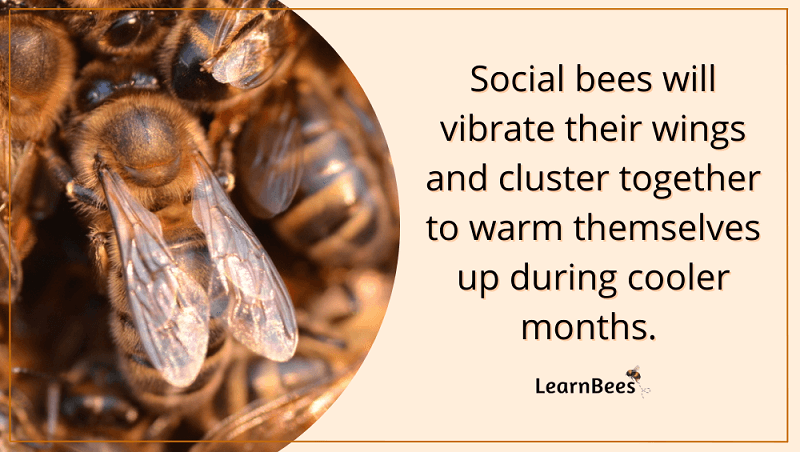
Speaking of honey bees:
Honey bees use their wings to help produce honey.
Honey is the sticky, sweet substance made by honey bees to eat during the winter when flowers are scarce.
As it turns out, honey bees fan their wings over nectar to help reduce the water content. This causes the nectar to dehydrate slowly, which thickens it up and gives it the syrup-like honey texture we’re all familiar with.
And last but not least?
Bees also use their wings to avoid drowning in water.
Bees can’t swim, so they rely on safe landing perches like rocks and sticks to drink from.
But what happens if a bee accidentally falls into the water?
They’ll use a technique called “hydrofoiling.” Hydrofoling is when bees use their wings to create waves that propel them forward to a landing perch.
That said, hydrofoling is a labor-intensive job. If the bee can’t find its way to safety within 10 minutes, it’ll drown.
What Are Bees’ Wings Made Of?
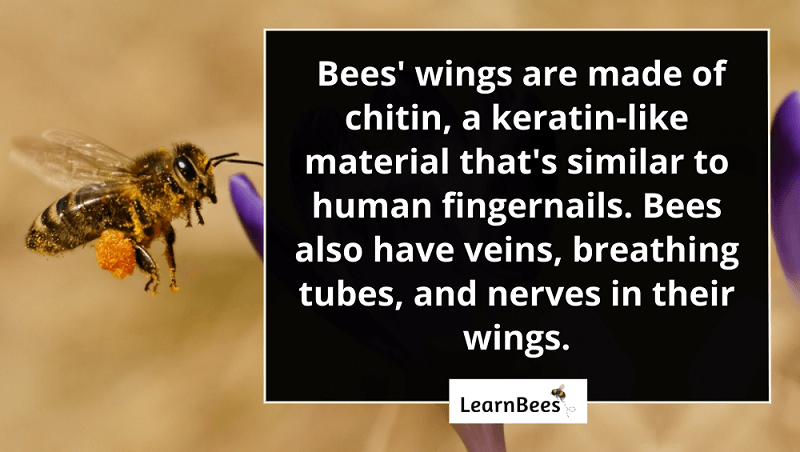
Bees’ wings are made of chitin (KITE-IN), a keratin material similar to what makes up human fingernails.
But remember:
Bees’ wings aren’t as delicate as they may look.
In fact, they’re incredibly strong and allow some bee species to carry up to 80% of their weight in pollen and nectar. Flying is a bee’s primary method of transportation, so their wings have to be durable to do the job.
As mentioned, bees’ wings tend to be transparent, like clear glass. Besides chitin, bee wings contain veins, hairs, nerves, and breathing tubes.
Despite their strength, a bee’s wings wear and tear as the bee ages. It’s not uncommon to see older bees with tattered or ragged wings.
Unfortunately?
Bees cannot regrow their wings if they’re old, deformed, or broken.
FAQs on Bees’ Wings
- Does a bee have 2 or 4 wings?
- What are the wings of a bee called?
- What are the wings of bees made of?
- Do bees really fly?
- Do bees always have four wings?
- How do bees actually fly?
- Are bees’ wings delicate?
- Why do bees flap their wings?
- How many times do bees beat their wings?
- How big is a bee’s wing?
- Are bees too fat to fly?
- Do bee wings have bones?
- Why do bees fly at you?
- Can a bee survive if it can’t fly?
Does a bee have 2 or 4 wings?
A bee has four wings. Two of the wings are large, and two of the wings are small. The larger wings are called ‘forewings,’ while the smaller ones are called ‘hindwings.’
The front and back wings connect during flight using a row of hooks called a ‘hamulus.’
The wings are connected to the ‘thorax’ – located in the middle of the bee’s body, between the head and abdomen. In addition to flying, bees use their wings for other purposes as well, such as cooling the hive, generating heat, and buzz pollination.
—> Go back to the FAQs on bees’ wings
More to Explore:
- Do Queen Bees Eat Honey?
- Are Worker Bees Male or Female?
- Queen Bee Versus Worker Bees – How Do They Compare?
What are the wings of a bee called?
Bees have two pairs of wings called “forewings” and “hindwings.” The forewings are the larger pair that most people notice. Hindwings are smaller and can often be seen in pictures or under magnifying glasses.
The wings are filled with many veins and a substance called ‘resilin’ which acts like rubber. Resilin is incredibly durable and allows for great flexibility and strength – both necessary attributes for successful flying.
Bees use their thorax muscles to rotate and flap their wings in a quick, smooth motion whenever they fly. This movement, in addition to the superelastic flexibility given by resilin, allows bees to fly.
—> Go back to the FAQs on bees’ wings
More to Explore:
- Do Carpenter Bees Pollinate?
- How Long Do Bumble Bees Live?
- Honeybees vs. Bumblebees: How Do They Compare?
What are the wings of bees made of?
The bees’ wings are constructed from chitin, a material similar to keratin that human fingernails are also made of. Chitin is very strong, allowing some bee species to transport up to 80% of their body weight in pollen and nectar.
—> Go back to the FAQs on bees’ wings
More to Explore:
Do bees really fly?
Yes, bees fly as their primary method of transportation. Their wings allow them to fly several miles for food and water. As the bee ages, their wings can become tattered due to all the miles they’ve spent flying.
If you look at an older bee’s wings under a magnifying glass, you’ll notice ragged edges and deterioration. This signifies that the bee is probably at the end of its life. Many bee species have a short lifespan of only a few weeks.
—> Go back to the FAQs on bees’ wings
More to Explore:
- Ground Bees: Are They a Threat to Your Yard?
- Wasps vs. Honeybees: Are They Different?
- Do Bumble Bees Bite?
Do bees always have four wings?
Yes, bees always have four wings. There are two front wings that are larger. These large wings are called forewings. There are also two back wings that are small – called hindwings.
—> Go back to the FAQs on bees’ wings
More to Explore:
How do bees actually fly?
Bees have flexible wings that can rotate and twist as they fly. They use their thorax muscles to move the wings in a quick, smooth motion – creating lift and propelling the bee forward.
Bees also have something called resilin, which acts like a strong rubber that helps them have the flexibility needed to fly.
Interestingly enough, different bee species have unique vein patterns. Entomologists (insect scientists) can often identify bee species by looking at these patterns.
—> Go back to the FAQs on bees’ wings
More to Explore:
Are bees’ wings delicate?
Bees’ wings are not as delicate as you might think. They are powerful and durable thanks to the chitin material they are made of, as well as a substance called resilin which provides flexibility.
Resilin is located in the folding positions of the hindwings. This helps prevent the hindwings from being damaged and contributes to their elastic deformation while flying.
However, bee wings can become tattered over time due to wear and tear from flying long distances. If you look at an older bee’s wings through a magnifying glass, you will notice ragged edges and fraying, which can signify the end of its life.
—> Go back to the FAQs on bees’ wings
More to Explore:
Why do bees flap their wings?
Bees flap their wings for many things, including flying, making honey, buzz pollinating, hydrofoiling, and cooling the hive.
That said, each bee species is different, and they all don’t necessarily use their wings for the same thing. For example, most bee species don’t produce honey, so they don’t use their wings for that. Additionally, not all bees buzz pollinate.
—> Go back to the FAQs on bees’ wings
More to Explore:
How many times do bees beat their wings?
Bees beat their wings many times per second, and the amount just depends on the species. Honey bees have been known to beat their wings 240 times per second.
—> Go back to the FAQs on bees’ wings
More to Explore:
How big is a bee’s wing?
The size of a bee’s wing just depends on the bee species. Most bees are known for having wings that are between 7mm to 10mm long.
—> Go back to the FAQs on bees’ wings
More to Explore:
Are bees too fat to fly?
No, bees are not too fat to fly. In fact, bumble bees are large bees that can fly while carrying up to 80% of their body weight in pollen, nectar, and water.
—> Go back to the FAQs on bees’ wings
More to Explore:
Do bee wings have bones?
Bees don’t have bones like humans do. Instead, bees have a protective exoskeleton (aka external skeleton) that covers their muscles, nervous system, and bodily organs.
—> Go back to the FAQs on bees’ wings
More to Explore:
- How to Repel Bees Without Killing Them
- How to Get Rid of a Bumble Bee
- What Are the Four Stages of the Bee Life Cycle?
Why do bees fly at you? Why do bees fly in your face?
Bees may fly at you for many reasons, including curiosity or trying to deter you from their nest. If a bee flies at your face continuously, you should back away from the area until you know if there’s a bee nest.
Remember that bees are gentle creatures that don’t sting for no reason. However, they may feel inclined to sting if you’re too close to their nest and they feel threatened.
—> Go back to the FAQs on bees’ wings
More to Explore:
Can a bee survive if it can’t fly?
No, a bee will not survive long in the wild if it cannot fly. Bees need wings for many things, including foraging for food and returning to their hive. Without the ability to fly, a bee will not be able to do either effectively, and it won’t last long.
